#15th century ad
Explore tagged Tumblr posts
Text






parchment stitching
pages from a cistercian breviary, produced in the cistercian nunnery lichtenthal abbey, c. 1450-1500
source: Karlsruhe, BLB, Cod. Lichtenthal 29
#again as you can see the stitching was done before the text was added#15th century#parchment#parchment repair#manuscript repairs#stitching#codicology#book history#cistercian breviary#Breviarium cisterciense#lichtenthal abbey#medieval manuscripts
732 notes
·
View notes
Text
“They [the people] love the Prince [Arthur Tudor] as much as themselves, because he is the grandchild of his grandfather [Edward IV]. Those who know him love him also for his own virtues.”
"Polydore Vergil remarked that ��a vast multitude of persons” flooded London when the date of [Henry VIII's] coronation was announced. “[E]verybody loved him,” Vergil wrote of the ceremony, likening Henry to Edward IV “the most warmly thought of by the English people among all the English kings...and for that reason [Henry] was the more acclaimed and approved of by all.”
— Don Pedro de Ayala on July 25, 1498 / Lyndsi Lewis, The Politics of Public Relations: Concepts of Image, Reputation and Authority in Henry VIII’s England (LSU Master's Theses, 2015)
#and the award for 'Most Helpful Grandad' goes to ...#edward iv#arthur tudor#henry viii#english history#tudors#15th century#16th century#my post#also adding/rephrasing the tags of my previous post (which I'll probably delete)#I didn't know that Edward and Henry VIII's alleged similarity was highlighted by actual contemporaries themselves! that's very interesting#(obviously this shouldn't be taken to mean that they were duplicates of each other and that their lives mirrored each other)(they did not)#yet another reason why the false idea of Henry VII obscuring Elizabeth of York's ancestry makes no sense. It was beneficial to their kids#also gotta love Edward IV being Public Enemy No. 1 in 1469-71 and getting slandered so badly by his own brother after his death#and committing the holy trinity of regicide + fratricide + war crimes during his reign#and STILL apparently being remembered as 'the most warmly thought of by the English people among all the English kings'#I don't know how he did it but that's A++++++ game
12 notes
·
View notes
Text




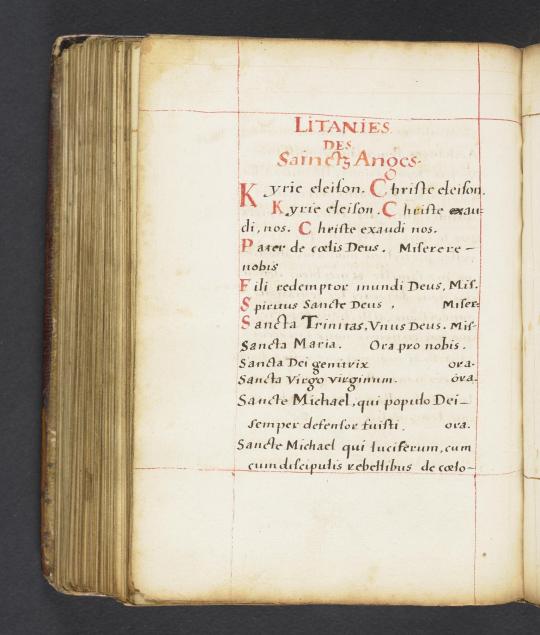
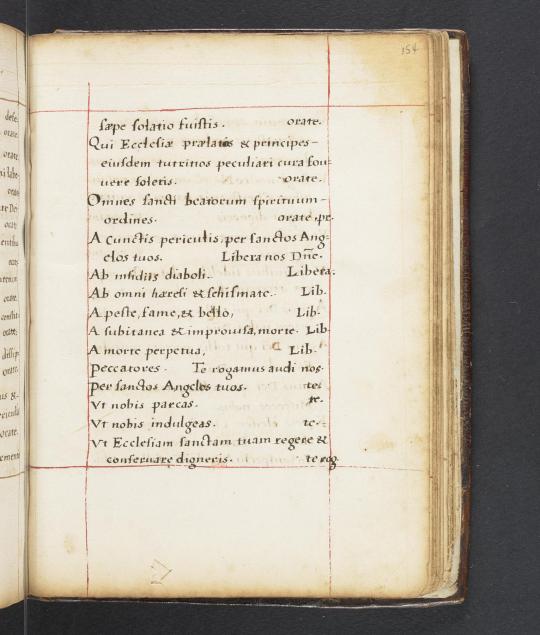
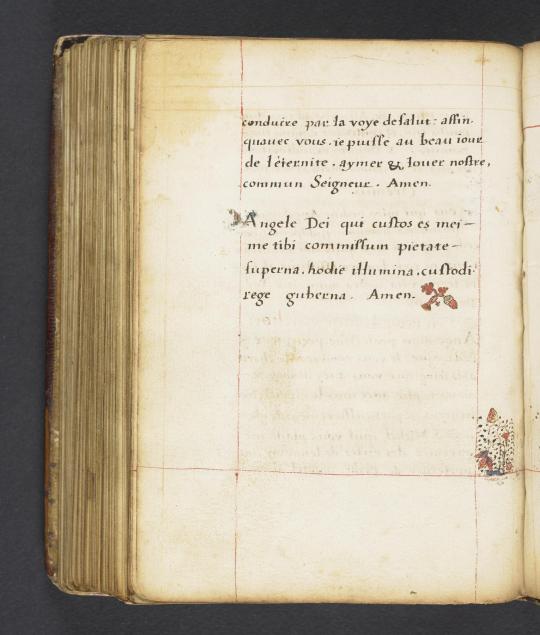


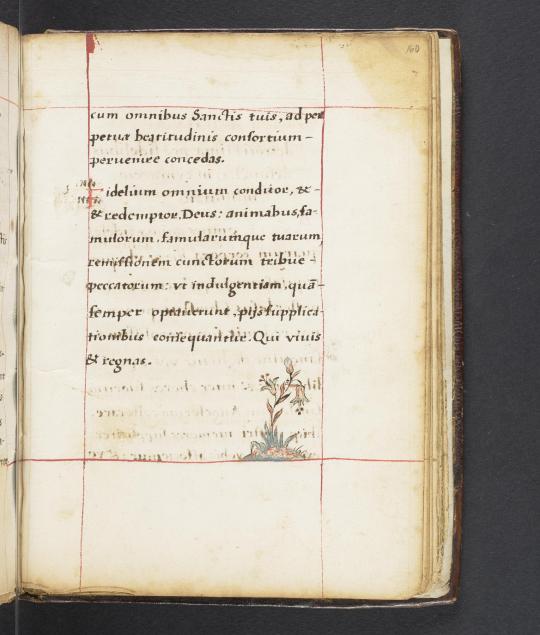
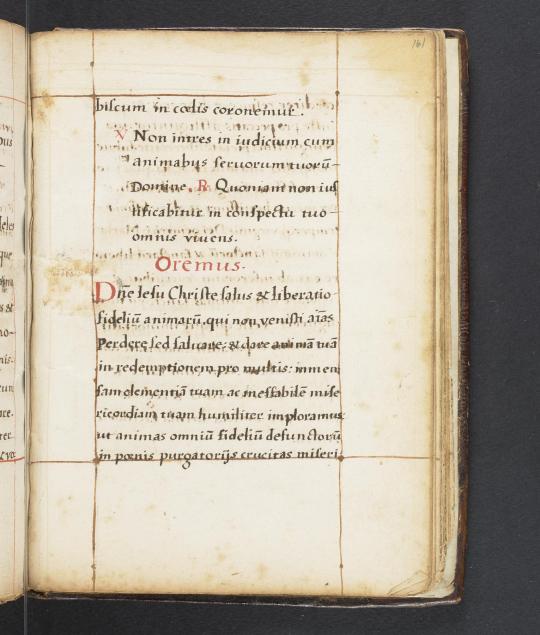

Today's #YearOfHours is @philamuseum 1967‑30‑121, a 15th c. book of hours, use of Paris. Prayers in French and Latin with occasional decorations, shown here, were added in the 16th century in a humanist hand.
🔗:
#medieval#manuscript#book of hours#year of hours#15th century#16th century#additions#added prayers#humanist#french#latin#decoration#book history#rare books
71 notes
·
View notes
Text
anyway look at my oc boy











this website is Not functional so heres the credits in order for the ones that didnt work -_-
1 2 3
4 5
6 7
8 9(meeeee) 10
#these should all have links for credit attached to them. i can kill myself if not#rick#ocs#i have like 2 more image coming too which is awesome. becomes 15th century wealthy Italian patron for oc images with normal money#EDIT APPARENTLY IF YOU GROUP THEM TOGETHER THE LINK GOES AWAY#GRR#ok um. adding the links into the post 1 sec
5 notes
·
View notes
Text
i just want to know if gnocchi is kosher or not, why is this ai-generated article trying to convince me that it originated as a "Passover dessert"
#HALP#i looked up if pasta was kosher or not. i found a source that said dry pasta was kosher and fresh pasta wasnt and it did not elaborate#so i figured 'hey gnocchi is pretty different from normal pasta. i should just look up if gnocchi is kosher'#and THATS how i got to that ai-generated article#it says gnocchi was invented in 1 ad. pretty sure potatoes werent in italy until the 15th century???#shitpost
3 notes
·
View notes
Text

The Norimitsu Odachi is a huge sword from Japan. It is so large, in fact, that it was said to have been wielded by a giant. Apart from the basic knowledge of it having been forged in the 15th century AD, measuring 3.77 meters (12.37 ft.) in length, and weighing as much as 14.5 kg (31.97 lbs.), this impressive sword is shrouded in mystery.
4K notes
·
View notes
Text
making progress :^) one more ~simple~ scene to throw together, then it’s onto, uh, the more ambitious ones … wish me luck …
making my temporary hiatus official
i’ve been goofing off for a hot minute now and, while i would like to recommit to finishing the next story updates in quick succession, it’s slow-going. i will also be traveling for the next couple of weeks as well as part of july—! so, this is just an announcement for whomever it concerns: i’m going to focus on building up a queue, with the caveat that it may take a few weeks to accomplish. i really wanted to start act two before the summer ends, but !!!! seems unlikely now, so my goal is just to get back to posting twice a week by august. hopefully, we can vicariously re-immerse ourselves in summertime vibes by, oh, october-ish. anyway, wish me luck ! ♥️
#lmao jk didn’t delete it after all !!!#anyway im a clown and keep making Changes#i added a new scene ???? technically 1.5#i’m at the part of the outline where like#it’s mostly vibes and#tiny scribbles in 15263 different pen colors#maybe i’ll post my paper outline when 1992 wraps#& y’all can see how bananas and Iterative#my ‘planning’ process is#saw a tweet comparing#plotbrain and vibes merchants#i am the latter … call me 15th century venice
38 notes
·
View notes
Text
“Edward IV was never the sole, undoubted representative of the kingship before I47I. The crowned, anointed and, most important, de facto king of nearly forty years standing, was still alive, never abdicated and was never deposed; he was free until I465 and safe thereafter so long as his heir was beyond Edward's reach ... Barnet, Tewkesbury and the prompt murder of Henry VI, the moment it was safe to do so, alone changed all this and secured Edward's de facto kingship at last. The 'first reign' was in fact the road to the throne.”
- B.P Wolffe, review of “Edward IV” by Charles Ross
#edward iv#english history#that's a really good point I think#Edward IV was definitely in a wildly different and far more vulnerable situation from other 15th century usurpers#Henry IV and Richard III both had the usurped kings in their control and both Richard II and Edward V were childless so their usurpers#didn't have to worry about direct heirs#Henry VII defeated Richard in battle and was thus not only able to avoid the stain of regicide but was also able to gain added legitimacy#God-given victory in battle; divinely ordained triumph etc#Richard III also didn't have any legitimate heirs & hadn't formally declared anyone else his heir either#(and was himself viewed as an usurper himself by many)#So without discounting their difficulties they were all ultimately 'de-facto' kings from the beginning. Meanwhile Edward IV lacked that#across his 'first reign' and still somehow managed to get through which I think is actually pretty impressive imo? All things considered?#Ofc that's not to say that the circumstances were totally neat-and-clean for Henry IV Richard III and Henry VII - that's laughably untrue#But it was fundamentally different and more 'secure' in comparison to *Edward IV's* specifically#(John Guy talks about this in 'Tudor England' as well)#That's not even getting into how Edward IV was so much younger than the other three usurpers (he was 18 to their 32 30 and 28 respectively)#when he ascended the throne. So ultimately I think that his first reign was certainly very different and more vulnerable#which I definitely think this should be kept in mind when evaluating it - particularly if the evaluation is comparative in nature#(eg: in terms of internal opposition; foreign opposition; support; room to make mistakes etc)#On the flip-side it's also VERY indicative where Richard III is concerned. Because however morally distasteful his usurpation may have been#on a personal level - he WAS ultimately the de-facto king and the best option for dynastic continuity. And was clearly attempting a#policy of pardon and reconciliation where his brothers' followers were concerned. So it speaks volumes that despite that - despite#having nothing to gain and everything to lose - so many people rebelled against him or defected to a rival claimant who could#at that point offer them no such manifest advantage whatsoever
2 notes
·
View notes
Text



Miniatures from a Judeo-Persian manuscript, Mashdad, Iran, 1853
According to the scribal inscription, the book was calligraphed by Eliyahu ben Nissan, known as "Gurgi" (the Georgian). The text is a transcription of the tale of Yusuf (Joseph) and Zulaikha (Potiphar’s wife), as told by the 15th-century Sufi poet and philosopher Nur ad-Din ‘Abd ar-Rahman al-Jami. The story of Joseph is the story of a Jew forced to live among non-Jewish Egyptians, who despite hardships and temptations never loses his faith or forgets his true heritage; and when the time came, he revealed himself to his brothers and rejoined his family. This story must have had deep resonance, and even comfort, to the Jadidis in Mashdad (Persian Jews who were forcibly converted to Islam in the 19th century but continued to practice Judaism in secret); perhaps they commissioned this story as a reminder that like Joseph in prison, if they could keep their faith they would one day be rewarded.
567 notes
·
View notes
Text
Sewing a turn of the 15th century French kirtle in doll scale
Another day, another historical doll outfit! This time it's Late Medieval. This was a popular style from about 1380-1420 France and Alpine area, but I specifically based this dress on French illuminations from the early 15th century, which mostly effects the details, like headwear. As always I hand stitched everything and stuck to historical construction methods as much as I could.
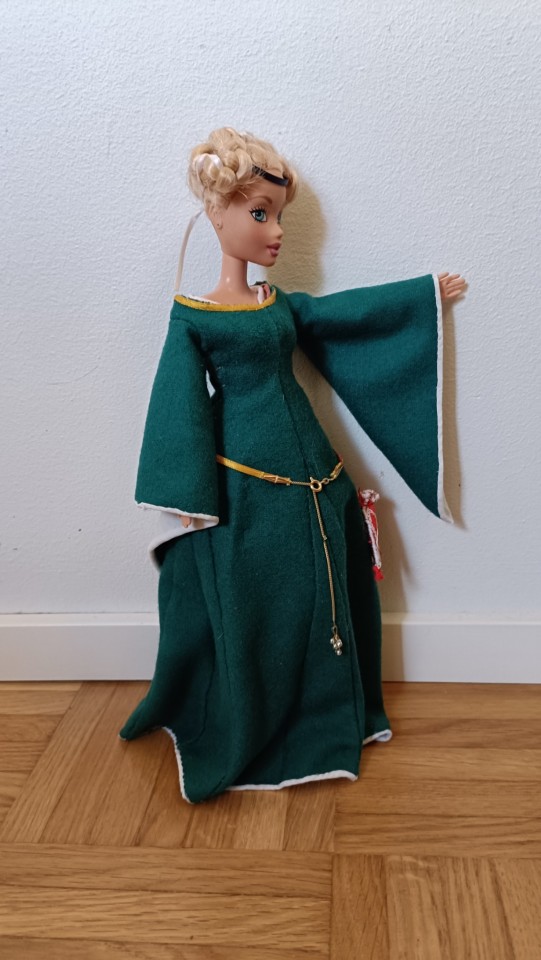
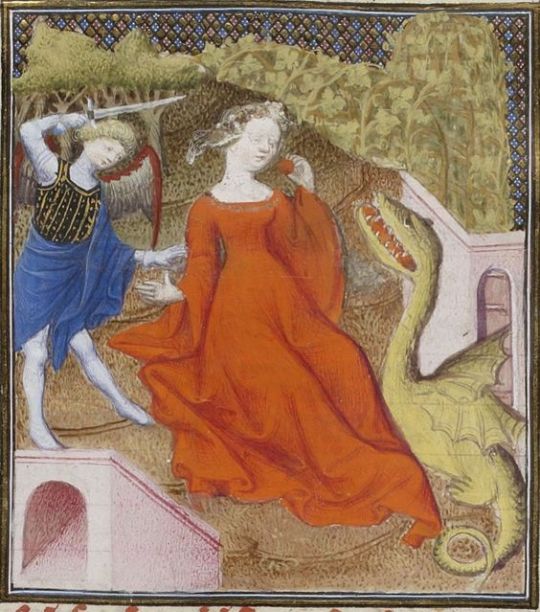
Chemise
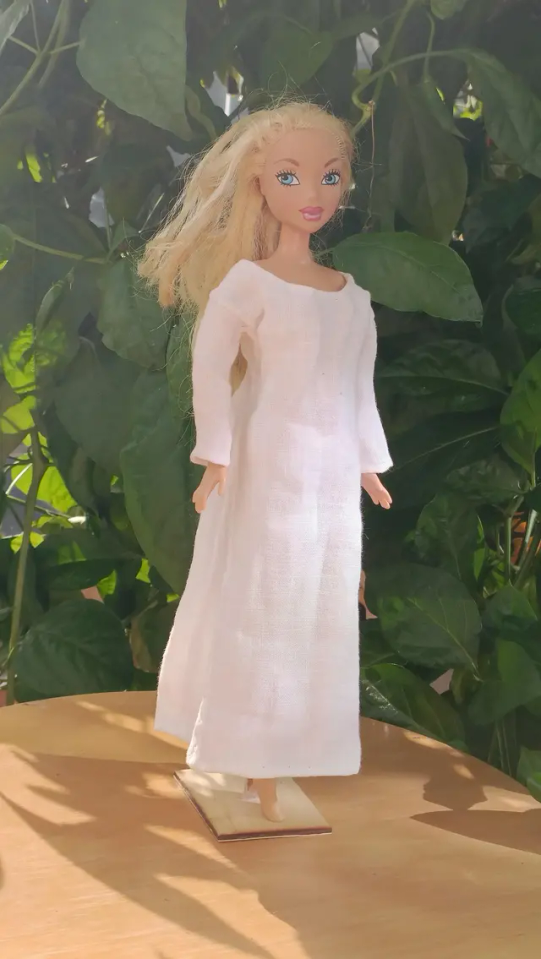
I made a very simple chemise. The construction is based on what we know from extant finds, made out of simple rectangles and triangles, like earlier unlaced kirtles. Based on illustrations, chemise was fairly slim but unfitted enough it didn't need closures. I made it from linen, because it's not very gathered and won't bulk up too much, so I don't need to use my very fine cotton voile.
Cote

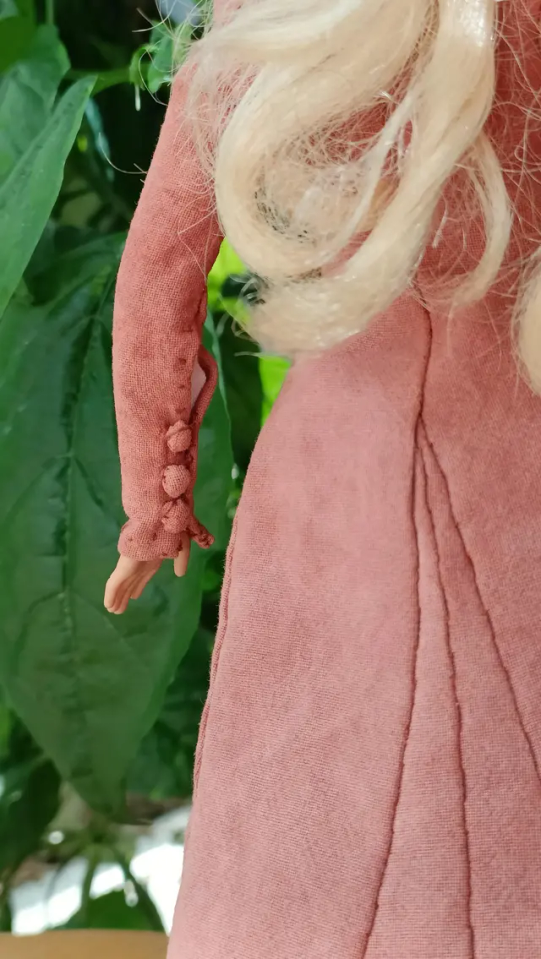
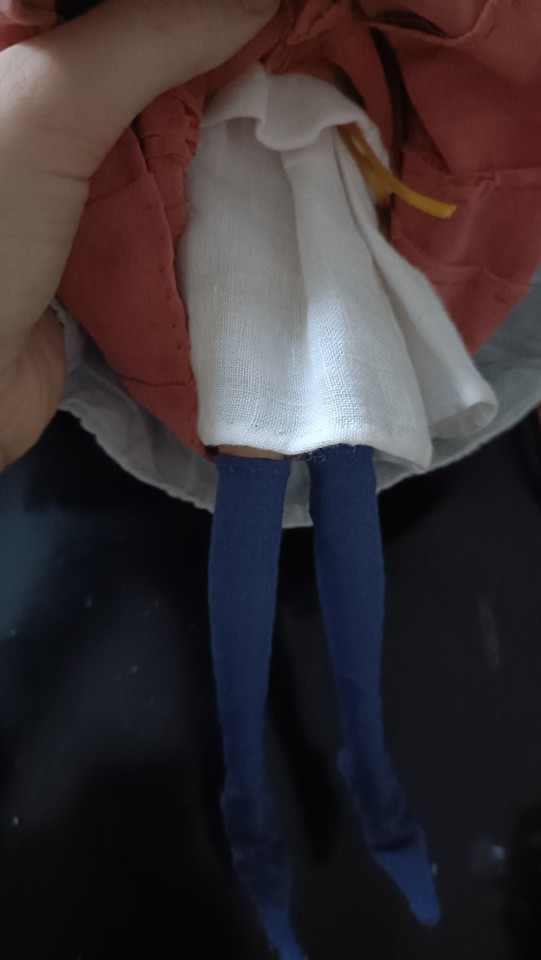
Cote is just the French word for kirtle, so appropriate here. This is the supportive layer cote, which was sort of an undergarment, but was considered fully dressed, if informal on it's own. The sleeves on this underlayer were always long and either fully fitted or gathered at the wrist. Some fitted sleeve styles had a flare at the wrist which covered the hand. The very fitted look was achieved with buttons. The silhouette was smooth and fitted, the waistline was slightly above the natural waist, though that was not as pronounced in France as in Northern Italy. Abdomen was emphasized, round lower stomach was the body ideal. The cut of the dress left plenty of room there. To fill that room I folded the chemise under the abdomen as a sort of padding. This was common to do with any kind of skirts, primarily to raise the hem when working, but why not for this purpose also? The necklines were fairly low and very wide.
I used cotton because I didn't have suitable thin enough wool that wouldn't have created too much bulk on this scale, but the cote should have been made from. The cotton is tightly woven and sells the look of a woven wool in this scale well enough for me. I didn't finish seems or line it to avoid bulk. I did give the lacing a cording to reinforce it and avoid wrinkling. The cotton was originally white, but I dyed it with iron oxide, basically rust, which at least is very much historical.
Hose



I made the hose from cotton as well for the same reasons as I did the cote. Long pointed style became fashionable around this time, as well as sewing leather soles in the bottoms of the hose instead of using shoes. Though often pattens (wooden flipflops basically) could be used when walking outside to protect the leather soles.
Cornettes or horned hair
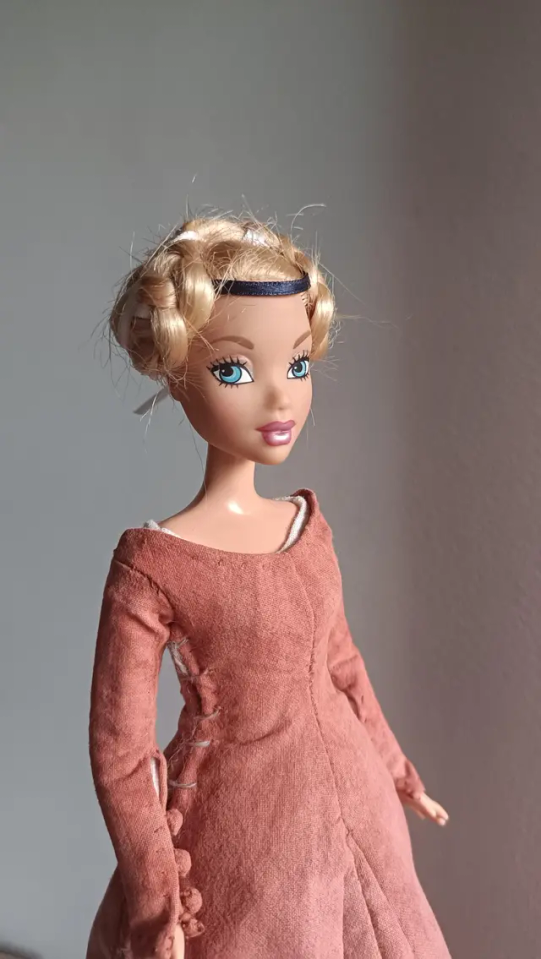
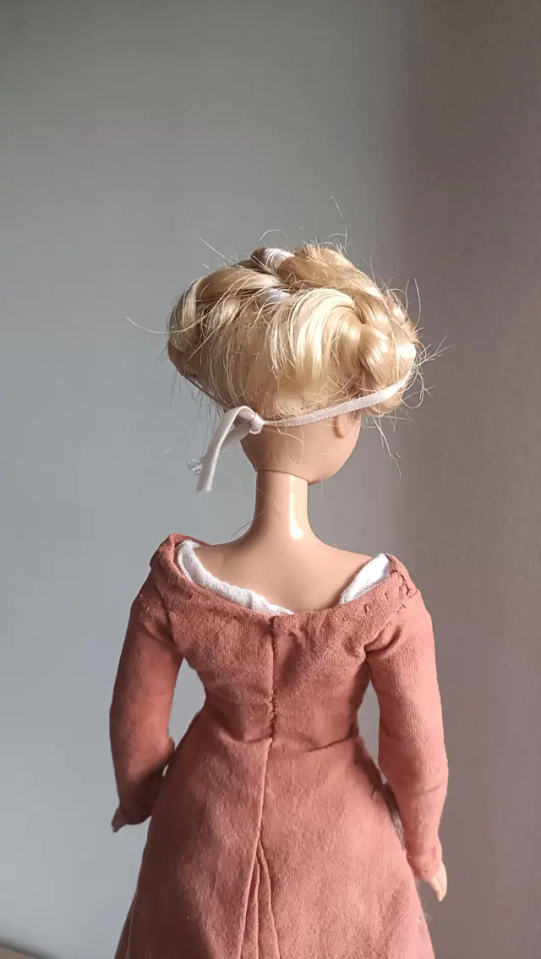
I tied the hair with a tape on cornettes, where the volume of hair was tied on the temples to create a bit of horned appearance, especially when combined with the horned headwear. The sort of fillet which became more of a forehead loop seemed to have been tied into the hair, which I did.
Cotehardie
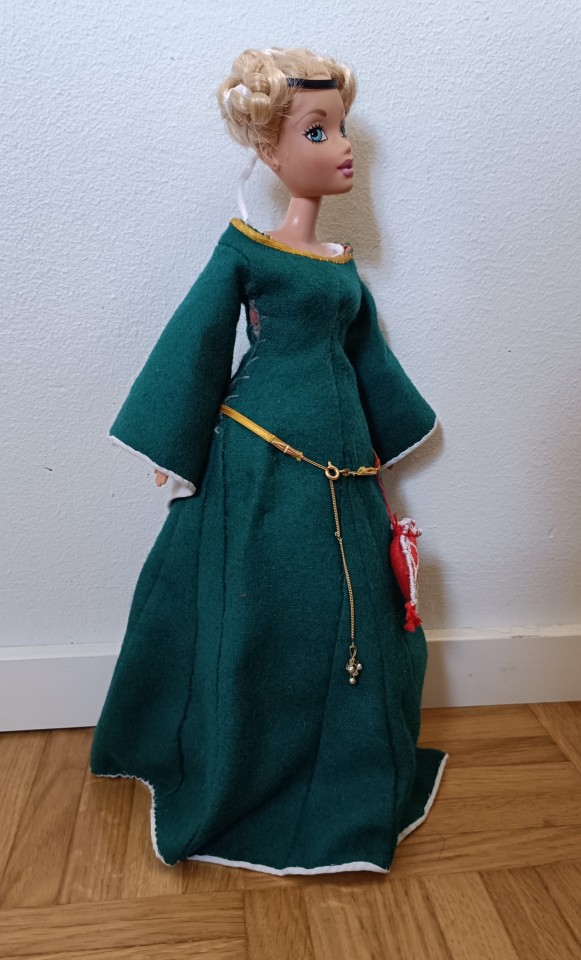
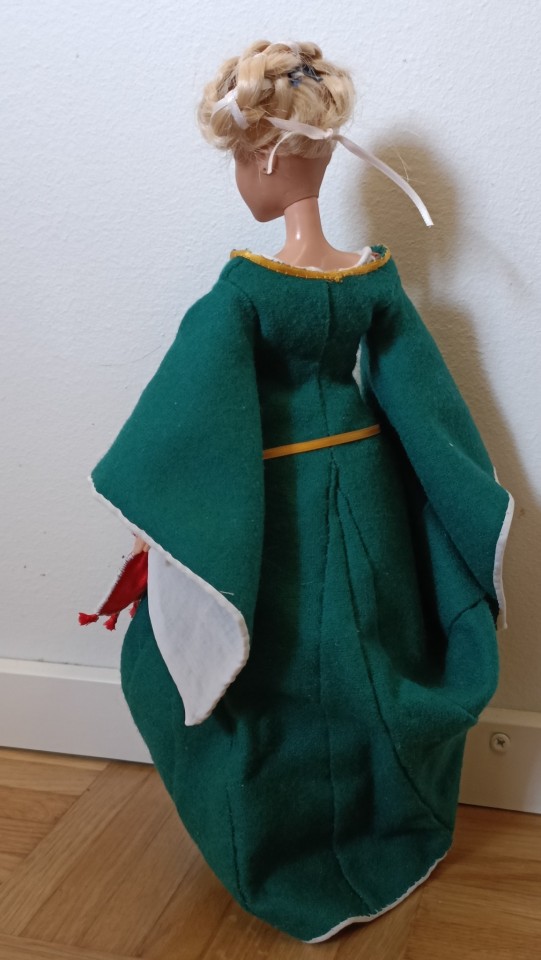
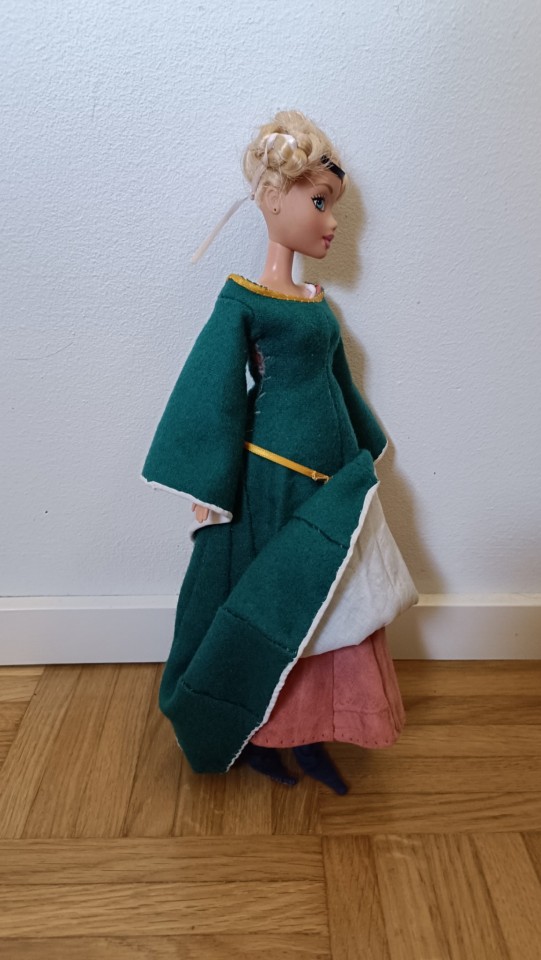
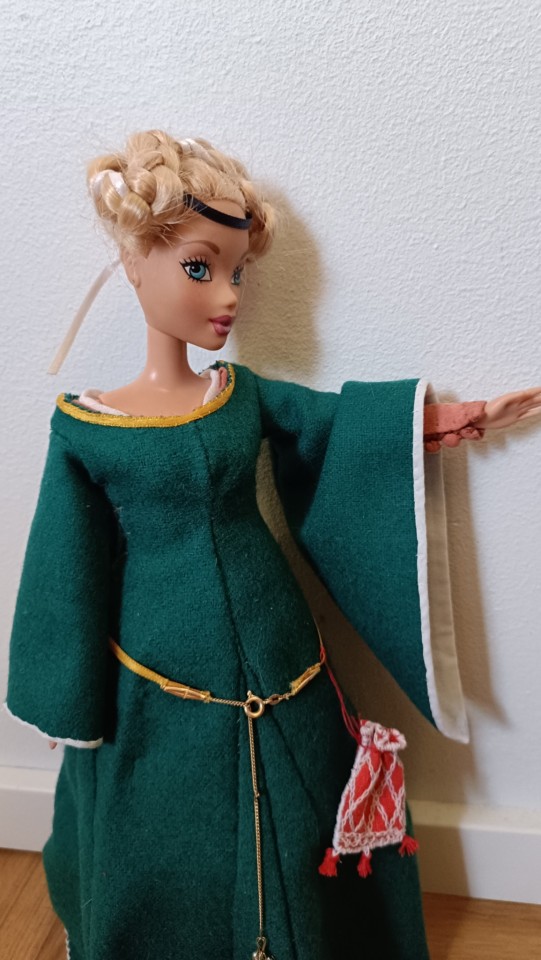
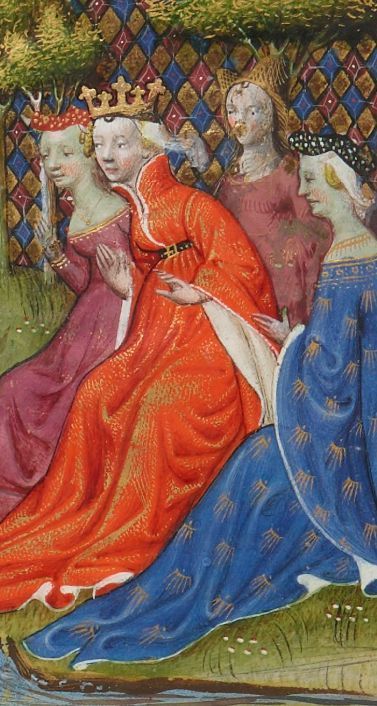
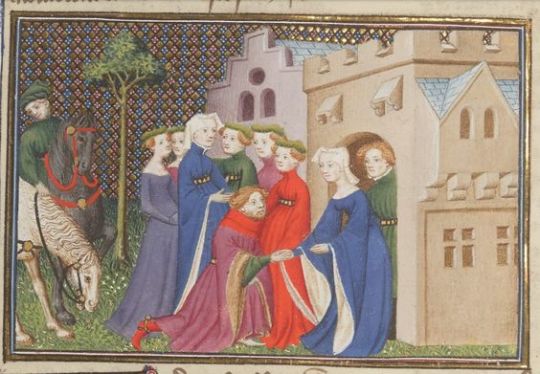
Cotehardie meant literally "bold cote", and in France that was what the formal outer cote was called. It was basically the same as cote, but made from more expensive materials and often had large hanging sleeves. I went with widening triangular sleeves, since they were perhaps the most popular sleeves at the time. I used fine fulled wool (verka) I had enough scraps left from. White fur was popular lining material, but obviously I can't use fur in this scale, I wish I had some light white velvet, it would have been pretty good, but I didn't. I lined the skirt and the sleeves with white cotton to imitate the look without adding too much body or extra bulk. I decorated the neckline with a simple golden trim. I thought about adding a bit of golden embroidery around it too, like seemed to have been popular, but my local crafts store had run out of golden thread so I decided to go with this only.
Accessories
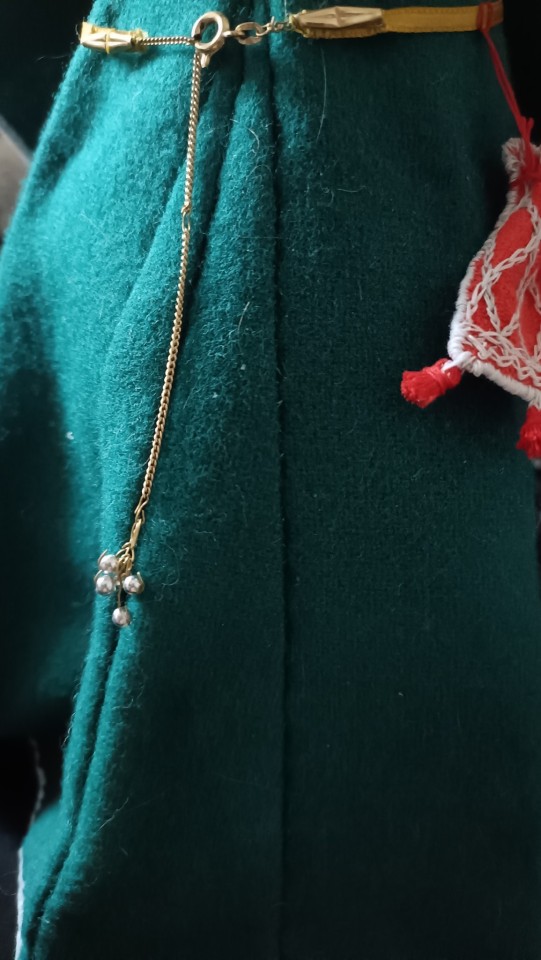
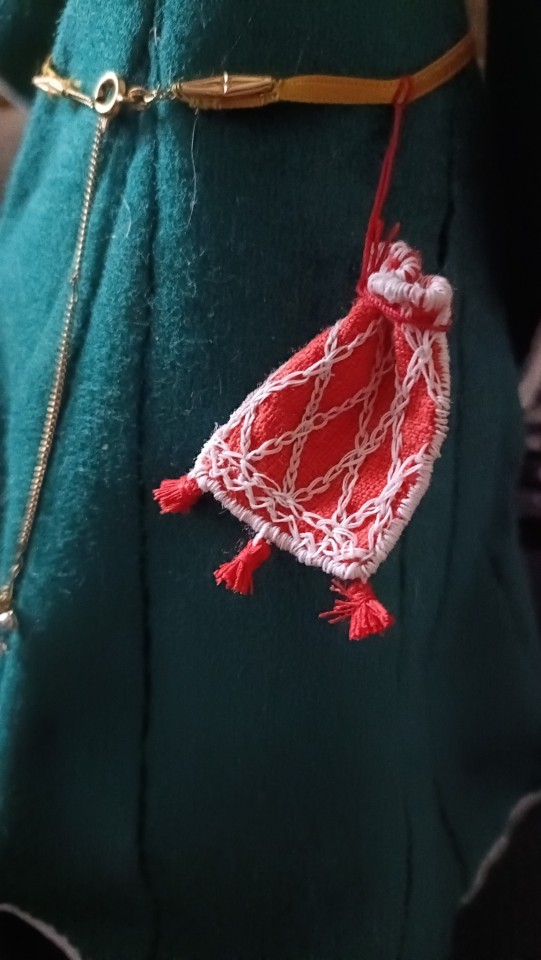

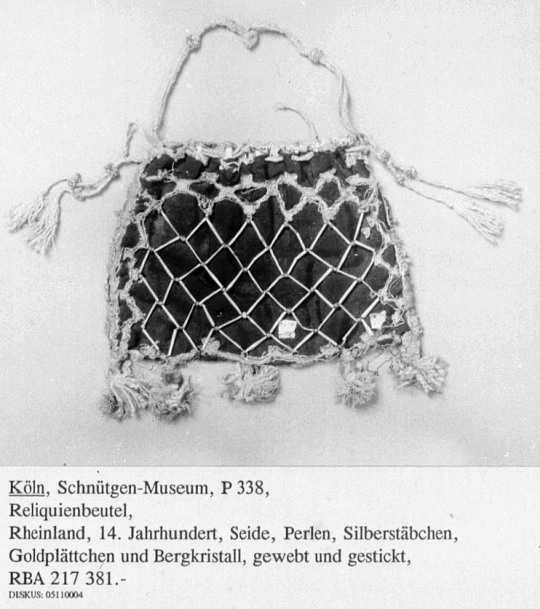
Unlike the belt used with houppelande, which was below bust, the belt used with the kirtle or cotehardie, was very low, under the abdomen to emphasize it. I went for a silk belt look, which I'm imagining is embroidered/woven with golden thread, since embroidery that small would have been too painful. I had an old broken necklace, which I could use for the metallic parts.
With the pouch I went for the tasseled drawstring look, with simple embroidery manageable in this scale. I used linen for it.
Headwear
I made her a chaperon, which likely was where the escoffion got it's beginning, escoffion being the round tube-like headwear worn on top of the head seen in several primary source images above. Early form of escoffion was becoming very popular at the time, though chaperon's were still seen on women too. Chaperon, as seen below both on the left-most woman and the man in the middle was actually just the hood rolled into a circle.

Because the horned look was popular, the escoffion and chaperon were often worn over the wired horned veil, so I first made that. I made it from cotton to make it as light as possible. It was just a square I hemmed. I just used some wire to poke out the horns from her hair and pinned the veil close from the back and onto her hair from the top.


Then I made the open hood. It was just the regular hood which had become very popular during the last century and which had ever longer narrow tip, but it was pinned and worn open, probably because of the hair style and to again create the horned look. I made if from the same cotton I made the hose, even though it too should be from wool. But it was already too bulky as it was.



And finally I could make the chaperon. Here's first chaperon without wire or veil under it and then with those. The effect isn't as pronounced as I would have hoped because the hood is too bulky, but there is an effect which is nice.



#fashion history#historical fashion#sewing#custom doll#ooak doll#fashion doll#historical sewing#medieval fashion#late medieval fashion#history#historical costuming#my art#doll customization#dollblr#dolls#doll clothes
449 notes
·
View notes
Note
I got the same ask, so I just want to add what Kristen L. Geaman wrote, which sums it up:
"It is time to stop seeing queens as apolitical or politically active queens as exceptional: "The question is not whether women exercised power; it is how and why."
All three WotR queens were in such wildly different situations, it's frankly impossible to conduct a side-by-side examination to decide which one of them had "the most" power/influence/authority. Theoretically, however, they all had the same social & institutional power and scope of action and used it accordingly.
(To be clear, this includes Margaret of Anjou. We really cannot claim that she had "the greatest power and influence" by any reasonable parameter because her power and influence in itself was really no different from any other 15th or 14th century queen: what was different - or more importantly, was perceived as different - was the situation around her and the manner in which it forced her to use that power and influence (ie: "how" and "why"). This was in the later half of her queenship, not from the beginning. And even then, it's possible that the perception of her activities say more about her husband's position/authority than her own, or may say more about how her enemies wanted her to be perceived rather than an accurate reflection of her actual actions. We just don't know).
This logic applies to a very similar ask I received on the same topic: whether the perception of gender changed across the WotR and late 15th century. "Gender" by itself is too broad a concept (and for who? For women in general? For noblewomen? For queens?), but even if we narrow it down to the four queens in question, it's impossible to form a conclusion and unwise to even try. There are so many wildly different factors that influenced the four queens' activities and perception beyond their gender - their social status, nationality, length of queenship, political opposition and the propaganda it generated (etc) - that to compare them through a solely gendered wavelength feels very limited and rather dishonest. We can perhaps compare some aspects of their queenship (eg: Margaret and EW's roles in their sons' councils - see below) but those are individual elements and should be analyzed across a broader spectrum of late medieval English queens - it shouldn't just be merely limited to the WotR ones.
An example that comes to mind about the circumstantial differences of the three queens is their role in their children's marriages. Margaret was in a rare and unique position to negotiate her son’s dynastic marriage on her own due to the absence of the king, and did a great job; but this cannot by any means be used to judge how she would act in more “regular” circumstances. None of Elizabeth Woodville’s royal children married during her queenship except for her youngest son Richard, who didn't marry a foreign bride but an English heiress for monetary rather than dynastic purposes; she nonetheless played a significant role in his wedding, and her husband’s will specified that she was to "rule and govern" her daughters' marriages. Elizabeth of York’s eldest son and her eldest daughter made grand foreign marriages during her queenship under the most "regular" circumstances; she played an especially vital role in the latter, something that is regularly overlooked by historians. In any case, the situations of all three queens were wildly different: we can't use them to compare who did "the most" or how a WotR English queen's role "evolved". It wouldn't be a fair line of analysis.
For another example, take queenly dowers. We can't compare what Margaret of Anjou got with what Elizabeth Woodville & Elizabeth of York got on a "gendered" or even "queenly" lens (as historians tend to do, often for EoY and occasionally for EW) because Henry VII and Edward IV simply could not logistically endow their queens on the same capacity as Margaret was endowed. It was objectively a practical problem, not an ideological one. Even if they had been kings in regular circumstances, such a dower was financially unwise; as usurpers with a very limited supply of lands, it was completely unfeasible. This unfeasibility is especially true in EW's case because as an English gentlewoman with no dowry/political alliance/prestige of her own, she brought no advantage whatsoever to the king or to England, and marriage to her in fact made them lose an invaluable diplomatic card that could have potentially spelt disaster for their dynasty. It would have therefore been somewhat expected for her to receive a lesser dower in that circumstance - though of course, ultimately speaking, royal supply was limited and she might've probably been given the same high amount if more was available. That's not even getting into how Edward IV himself was running his own household on a significantly lesser budget than both Henry VI and Henry VII did, meaning that EW's dower had nothing to do with queenship and everything to do with royal policy as a whole. (I'm not getting into Henry VII and Elizabeth of York's situation because ik you've already talked about it a lot, but suffice to say, the idea that he was using her dower to somehow "control" her is nonsense. If anyone wants an example of a king of England who actually seized his wife's dower lands, look up Edward II and Isabella of France; if anyone wants an example of a queen consort whose ability to administrate and collect income from her dower lands was neglected and overlooked by her husband, look up Berengaria of Navarre. There are queens who this accusation actually applies to; Elizabeth of York isn't one of them.)
There's also the major problem of historical evidence. To claim that we can "compare" the influence and activities of the three queens is 1) to imply that we have surviving evidence for all their activities as queen, and 2) more importantly, to imply that we have equal surviving evidence for all their activities as queen. We really, really don't. More than *120 letters* have survived for Margaret of Anjou, meaning that we know infinitely more about her "daily" queenship than any other 15th century queen. It doesn't mean that she did more; it merely means that, because evidence has been lucky enough to survive for her, we know more about her activities as queen (patronage, intercession, diplomacy). I would kill to have the same amount of information for Elizabeth Woodville and Elizabeth of York: it would help flesh out their queenships so much. It would also go a long way in further establishing their personalities, their relationships with other nobles, their approaches to lordship, etc. But for now, information is very limited, and that needs to be kept in mind & specified when discussing both the Elizabeths, just like it needs to be kept in mind & specified when discussing Margaret (ie: she shouldn't be singularized). Similarly, there's also a very uneven level of contemporary evidence for late medieval English kings' reigns in general: for example, as Charles Ross has said, "The reign of Edward IV was singularly ill-served by contemporary writers of history". We possess very less strictly contemporary information about his reign, and this massive gap is "only very partially filled by the vernacular city chronicles". His entire chamber records don't survive: imagine how much royal activity has consequently been lost, and how little we know about him & EW compared to Henry VII & EoY as a result. Henry VI's reign also has this major problem when it comes to lack of surviving contemporary information, though like I mentioned, the survival of letters for Margaret of Anjou mean that the lack of information is relatively alleviated when it comes to her queenship and actions specifically. We also have more detailed extant information for Elizabeth of York's diplomatic role & activities compared to her predecessors, from what I understand, thanks to ambaassadorial letters. The point is simply that with such uneven evidence which directly affects the way we perceive their queenly activities, it doesn't really make sense to "compare" them. Rather, I think it would make more sense to analyze them individually and acknowledge their vastly different circumstances when doing so. On a broader theoretical level, like I mentioned, we know for a fact that they all had the same social & institutional power and scope of action. What was different was their circumstances (ie: "how" and "why").
One thing I do want to point out, though, is that Elizabeth Woodville did have unique political authority during her tenure as queen. Her official appointment in royal councils in her own right - for both the crown prince and Richard of Shrewsbury - was unusual & exceptional for late medieval queens, even though historians rarely emphasize it to the extent that they should. Margaret, whose activities with her son's council are often hailed as "extraordinary" and proof of her "superior" political power (I'm putting them in quotes because they're the words I come across), was in fact never actually a part of the council in her own right and never came close to possessing the position, authority or formally acknowledged importance that Elizabeth had. So, I would say that yes, Elizabeth Woodville was undoubtedly given unconventional political authority & formal appointments during her queenship, made even more surprising by the fact that these were not during the King's absence or incapacity but during his presence and the peak of his own power. Historians need to acknowledge and highlight this more than they do. However, any "comparison" (if it can be called that) of this unique and official position of Elizabeth's can't just be limited to her daughter or other WotR queens, and therefore can't be used to judge Elizabeth of York: it was unusual and unprecedented for all 15th century (from what I understand, also 14th century) queens in general and should be discussed accordingly.
What are the differences in the powers of the three queens in wars of the roses? Margaret of Anjou should be the greatest power and influence? Elizabeth Woodville has many formal authorities, and Elizabeth of York is very symbolic?
No because all medieval queens consort had both formal and symbolic authority. Please check my queenship tag to find out more.
#I hope it's okay if I added this!#It was kinda scary lol - I was just starting to answer this same ask and then saw your post 😅#queenship tag#I don't think I explained the last point well but what I mean is that it's not fair to solely compare Elizabeth of York to Elizabeth#Woodville and claim that EoY lacked the formal position & authority her mother was given when it came to their sons' councils -#because no other 14th or 15th century queen had that position or authority either (including Isabella of France and Margaret of Anjou)#The position given to EW was the unusual exception not the rule -#so how can we solely judge Elizabeth of York's activities on the basis of that?#Or if we do judge her then you have to judge every other queen by the same logic - once again including Isabella and Margaret#Nobody is willing to do THAT though. Historians never emphasize how unusual Elizabeth's formal appointment in her sons' councils#was and what means for her queenship and late medieval queenship as a whole#it's only brought up when we have to compare her daughter to her - which is unfair to both Elizabeths
51 notes
·
View notes
Text
Bing Crosby - White Christmas 1942
"White Christmas" is a song reminiscing about an old-fashioned Christmas setting. Written by Irving Berlin for the 1942 musical film Holiday Inn, the song won the Academy Award for Best Original Song at the 15th Academy Awards. Originally sung by Bing Crosby, it topped the Billboard chart for 11 weeks and returned to the number one position again in December 1943 and 1944. His version would return to the top 40 a dozen times in subsequent years.
Since its release, "White Christmas" has been covered by many artists. Crosby's version is the world's best-selling single (in terms of sales of physical media), with estimated sales in excess of 50 million physical copies worldwide. The Guinness Book of World Records 2009 Edition lists the song as a 100-million seller, encompassing all versions of the song, including albums. Crosby's holiday collection Merry Christmas was first released as an LP in 1949, and has never been out of print since.
The song established that there could be commercially successful secular Christmas songs - in this case, written by a Jewish immigrant to the US. Before 1942, Christmas songs and films had come out sporadically, and many were popular. However, "the popular culture industry had not viewed the themes of home and hearth, centered on the Christmas holiday, as a unique market" until after the success of "White Christmas" and the film where it appeared, Holiday Inn.
The version most often heard today on the radio during the Christmas season is the 1947 re-recording. The 1942 master was damaged due to frequent use. Crosby re-recorded the track on March 19, 1947, accompanied again by the Trotter Orchestra and the Darby Singers, with every effort made to reproduce the original recording session. The re-recording is recognizable by the addition of flutes and celesta in the beginning. In 1974, the 1942 recording of the song by Bing Crosby and The Ken Darby Singers was inducted into the Grammy Hall of Fame. In 1999, National Public Radio included it in the "NPR 100", which sought to compile the one hundred most important American musical works of the 20th century. Crosby's version of the song also holds the distinction of being ranked No. 2 on the "Songs of the Century" list, behind only Judy Garland's "Over the Rainbow," as voted by members of the RIAA. In 2002, the original 1942 version was one of 50 historically significant recordings chosen that year by the Library of Congress to be added to the National Recording Registry.
"White Christmas" received a total of 74,5% yes votes!
youtube
#finished#high yes#low no#40s#o1#o1 sweep#lo24#lo24 tie#lo4#soundtracks#bing crosby#english#film score
329 notes
·
View notes
Text
𝐋𝐮𝐩𝐞𝐫𝐜𝐚𝐥𝐢𝐚




What is Lupercalia?
Celebrated on February 13th - February 15th, Lupercalia was an ancient Roman holiday dedicated to the god Faunus, the wild horned spirit of nature, and the legendary founders of Rome, Romulus and Remus. The festival is believed to have far more ancient origins than its association with these mythical figures, likely stemming from earlier fertility rites and purification ceremonies.
The name of the festival, Lupercalia, is derived from the Latin word lupus (wolf), tying it to the legend of the she-wolf who rescued and nursed Romulus and Remus in the cave known as the Lupercal. This cave, located on Palatine Hill, became the heart of the festival’s rituals, emphasizing the protective and nurturing symbolism of wolves.
At its core, Lupercalia celebrated the themes of fertility, purification, and the harmony of nature. It honored two deities: Faunus, the primordial spirit of wild nature and fertility, and Juno Februata, the aspect of Juno associated with purification and the passions of love. The name "February" itself originates from Februare (to cleanse) and Juno Februata, underscoring the month’s ties to this festival.
The festival began with sacrifices of goats, symbolizing fertility, and dogs, representing purification. These sacrifices were followed by ceremonial rituals performed by Faunus’ priests, known as the Luperci. After consuming the sacrificial meat, the Luperci smeared themselves with the blood of the animals and dressed in strips of goatskin, referred to as "Juno’s cloak." They then ran through the streets of the Palatine Hill, carrying whips made from goatskin called februa.
Women who wished to conceive strategically positioned themselves to be struck by the whips, believing this act would enhance fertility, ensure conception, and guarantee safe childbirth. This ritual also served as a broader purification rite for the community, cleansing it in preparation for the coming New Year, which in the Roman calendar began at the vernal equinox.
The nine days of Lupercalia, from February 13th to the 21st, were believed to be a liminal time when the souls of the dead wandered the earth. Offerings of food and drink were left for them, with the living honoring the spirits as part of the festival's traditions.
Over time, the festival's elements shifted and evolved, blending with other traditions. February 14th, now celebrated as Valentine’s Day, originally marked the first day of Lupercalia, dedicated to Juno Februata and Faunus, when women prayed for fertility and blessings.
Lupercalia continued to be celebrated for centuries until it was officially abolished in 495 AD by Pope Gelasius I, who replaced it with a Christian feast day. Now, in modern times, even though Lupercalia is no longer a widely celebrated festival, it is often associated with modern Valentine’s Day or even a celebration of self-love. Today, it’s all about love, fertility, and connection. You can spend the three days of Lupercalia by offering yourself love and understanding, doing things that nurture your self-appreciation, and spending special time with your loved ones.
⠂⠄⠄⠂⠁⠁⠂⠄⠄⠂⠁⠁⠂⠄⠄⠂⠄⠄⠂⠂⠄⠄⠂⠁⠁⠂⠄⠄⠂⠁⠁
Magic Correspondences:
Colors: red, white, pink
Crystals: rose quartz, milky quartz, selenite, moonstone, ruby, garnet, lepidolite, green aventurine, emerald
Deities: Juno, Lupercus, Faunus, Venus, Aphrodite, Pan, Hera, Dionysus, Eros, Freyja, Cernunnos (deities associated with love, fertility, and abundance)
Animals: dog, goat, wolf, dove, swan, dolphin, ladybug, lovebirds, horse
Flowers: lavender, roses, snowdrops, hyacinths, tulips, orchids
Herbs: cinnamon, basil, jasmine, vanilla
Fruits: figs, cherries, grapes, bananas, strawberries, pomegranate, raspberries, apples
Symbols: phallus, hearts, wolves, whips, goat
Magick: fertility and abundance spells, self-love magick, sex magick, purification
⠂⠄⠄⠂⠁⠁⠂⠄⠄⠂⠁⠁⠂⠄⠄⠂⠄⠄⠂⠂⠄⠄⠂⠁⠁⠂⠄⠄⠂⠁⠁
Activities to do:
🐺 Take a relaxing long bath, and add some rose essential oil if you like
🐺 Spend time with your dog(s)
🐺 Watch some romance movies
🐺 Treat yourself to things that make you feel good, like lotions, perfume, or new clothes
🐺 Light red, pink, or white candles
🐺 Collect flowers and put them in your altar or room
🐺 Drink goat milk
🐺 Perform love, fertility, and purification spells
🐺 Give flowers to loved ones
🐺 Spend some time in your home, simply being naked because why not?
🐺 Bake heart-shaped cakes
🐺 Support dog shelters with a donation
🐺 Spend time with your lover
🐺 Listen to your favorite music
🐺 Show appreciation for your body
🐺 Take your health medicine
🐺 Decorate your space or altar with heart-shaped objects
🐺 Spend time and meditate in nature
🐺 Eat lots of chocolate
🐺 Practice yoga
🐺 Connect with deities associated with love, fertility, and purification
🐺 Drink some red wine
🐺 Dedicate a day to self-care, doing what feels healthy and good for you
⠂⠄⠄⠂⠁⠁⠂⠄⠄⠂⠁⠁⠂⠄⠄⠂⠄⠄⠂⠂⠄⠄⠂⠁⠁⠂⠄⠄⠂⠁⠁
Food and Drinks:
Drink red liquids like wine, cranberry or strawberry juice, consume goat dairy, cakes, muffins, chocolate, honey, cherries, champagne, grapes, hazelnuts, cinnamon rolls, cupcakes, any food with meat, apple pie, strawberries.
⠂⠄⠄⠂⠁⠁⠂⠄⠄⠂⠁⠁⠂⠄⠄⠂⠄⠄⠂⠂⠄⠄⠂⠁⠁⠂⠄⠄⠂⠁⠁
sources: Wicca: A Modern Guide To Witchcraft & Magick; Encyclopedia of Witchcraft: The Complete A-Z for the Entire Magical World by Judika Illes
#paganism#hellenic polytheism#deity work#hellenic pagan#roman mythology#lupercalia#valentine's day#witchy#witch#witches#witchcraft#eclectic pagan#hellenic paganism#pagans#pagan#pagan witch#paganblr#imbolc#candlemas#magic#magick#witchblr#deity worship#witch community#witchcore#tarot#wicca#wiccan#hellenism#hellenic
307 notes
·
View notes
Text

Potage From Meat
(15th century Italian)
"Take lean meat and let it boil, then cut it up finely and cook it again for half an hour in rich juice, having first added bread crumbs. Add a little pepper and saffron.
When it has cooled a little, add beaten eggs, grated cheese, parsley, marjoram, finely chopped mint with a little verjuice. Blend them all together in a pot, stirring them slowly with a spoon so that they do not form a ball. The same may be done with livers and lungs."
2 1/3 lb stewbeef 4 cups water "Rich juice": 31 oz (3 cans) concentrated beef broth 1 1/2 cups dry bread crumbs 3/4 tsp pepper 8 threads saffron 5 eggs 1 1/2 cups grated cheese (~ 7 oz) 3/8 cups chopped parsley 3/4 tsp dried or 1 tsp fresh marjoram 1 1/2 tbsp chopped fresh mint verjuice: 3 tbsp wine vinegar 1 tsp salt (to taste)
"Bring meat and water to a boil and cook 10 minutes; take meat out and cut up small; put back in water with broth, bread crumbs, pepper, and saffron. Simmer 1/2 hour over low flame, being careful that it does not stick. Mix in remaining ingredients; cook, stirring frequently, for about 5 minutes. This makes about 10 cups.
This is a rather meat-rich version; it also works with as little as half this much meat."
Source: Cariadoc's Miscallany
Otter's notes:
I used two beef stock cubes which was fine.
I wasn’t sure how small the meat should be cut, so I did pieces of a couple centimetres diameter. This worked well in my opinion.
I don’t enjoy skimming the scum off water I’ve boiled meat in, so I used fresh water for the second part. I did not find the result lacking in flavour.
Cariadoc isn't kidding about it sticking. Make sure to stir every 2-4 minutes. Stuck doesn't necessarily mean burned though.
It’s sooooo so tasty, can recommend

#sorry this took so long!!!#recipe#historical food#medieval history#medieval reenactment#medieval#history#cooking#food#i’ll be on my merry way now
162 notes
·
View notes
Text

Digital photograph of a painted rock art showing the figure of a ship, upright and painted in red. Made by San hunter-gatherer people, East of Porterville in the Western Cape, South Africa, mid 17th century
This image, which has been interpreted as a depiction of a seagoing ship, is from the mountains to the east of Porterville in the Western Cape. It appears to represent a wooden 17th or 18th century AD European vessel of the types that would have frequently been visible off the Cape coast at those time periods.
Portuguese ships first rounded the Cape in the late 15th century, and from the 17th century French, Danish, Dutch and English ships regularly visited Table Bay on the trade route to the East Indies. The leftmost element in the image may represent a monumental cross or other marker visible on the shoreline.
It has been suggested that the flags flying in different directions may indicate that the artist was unfamiliar with seagoing navigation; the apparent image of the tricolor indicates the painting to represent a Dutch vessel, indicating the painting to be perhaps mid-17th century.
262 notes
·
View notes
Text
Some Early Forms of Handwriting

MAJUSCULE
Relatively large letters generally contained within a single pair of imaginary horizontal lines; now usually called capital letters.
The Greek and Latin alphabets were both originally written in this way.
MINUSCULE
Relatively small letters whose parts often extend above and below a pair of imaginary horizontal lines; now usually called small letters or lower-case letters.
Minuscule writing was a gradual development, known in Greek from the 7th–8th centuries AD.
UNCIAL
A form of professional writing used in Greek and Latin manuscripts during the 4th–8th centuries AD.
The style consists of large (the name means ‘inch-high’), simple, rounded letters.
A later development, now known as half-uncial or semi-uncial, prepared the way for modern small letters.
Half-uncial is often found in early manuscripts from the British Isles, where the style of writing developed an ‘insular’ character of its own.
CURSIVE
Handwriting in which the characters are joined in a series of rounded, flowing strokes, which promotes ease and speed.
Often now known colloquially as ‘script’ (US) or ‘joined-up writing’ (UK), it was widely used from the 4th century BC, and eventually replaced uncial and half-uncial as the handwriting norm.
DUAL ALPHABET
The use of capital letters and small letters in a single system.
This development took place during the renaissance associated with the reign of Emperor Charlemagne (742–814), as part of the script which was later called Carolingian minuscule.
Carolingian writing, promoted throughout Europe, was an important influence on later handwriting styles.
For example, modern Roman printed letters derive from a classical style, based on the Carolingian, introduced in Italy by humanist printers in the early 15th century.
Source ⚜ Writing Notes & References ⚜ Worldbuilding ⚜ Typography
#writing reference#writeblr#dark academia#spilled ink#worldbuilding#handwriting#literature#writers on tumblr#writing prompt#studyblr#poetry#poets on tumblr#light academia#writing inspiration#creative writing#writing inspo#writing ideas#history#langblr#linguistics#albrecht anker#writing resources
285 notes
·
View notes